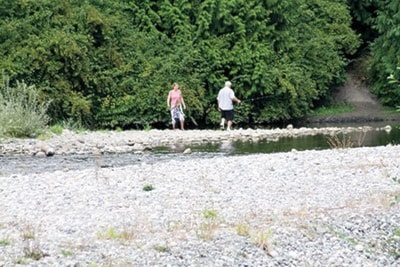Bruce Murray is a retired fisheries biologist who walks his dog every day near the estuary of the Englishman River in Parksville.
He sees carnage where there should be none and he said he believes the Department of Fisheries and Oceans (DFO) can do more to stop this illegal catch of pink salmon in the river.
Murray said he has seen up to a dozen people a day fishing the S-bend on the river between the ocean and the Orange Bridge that carries Highway 19A over the waterway. He said he's seen them with treble hooks, nets and bags of pink salmon.
"They are catching the fish, whacking them and keeping them and they should be releasing them," said Murray.
For the record, the Englishman River is a catch-and-release and barbless single hook waterway. One may not retain any species of salmon from the river, period.
Under the federal Fisheries Act, the DFO is responsible for the day-to-day management of tidal recreational fisheries and in-river salmon fisheries
It is difficult, said Murray, to figure out where one can and cannot retain fish from the DFO website which provides a table (if you can navigate your way to it) with catch and possession quotas for rivers you are allowed to fish. Understandably, it does not list all the rivers and streams in B.C. which are catch-and-release only. Some people, not seeing waterways like the Englishman River or Nile Creek on the DFO list, assume they can catch their limit of four salmon, said Murray. Or, he surmised, people are turning to the provincial freshwater regulations and also getting the wrong information.
Right now, pink salmon are massing in the lower reaches of the river near the S-bend and estuary, waiting for cooler and higher water levels so they can make their trek upstream to spawn.
"Let's get the word out that the Englishman River is a catch-and-release fishery," said Murray. "It should be closed — these fish are really under stress."
Murray said he understands there are staff-number challenges at the DFO, but he thinks the federal department can do more to help the pinks in the Englishman.
"If they don't have a guy to walk around because of cuts, why can't they just put up signage," he said.
Glen Lario is the acting regional coordinator of recreational fisheries for the DFO.
"The best way we can get info out there is through the web," he said, adding there are challenges associated with more signage.
"The trouble with signage, and I've been doing this for 30 years, is you put up signs and people tear them down."
Lario said the DFO website could be altered to make it more clear, perhaps adding one line on the quota/limit table suggesting that if you don't see a waterway listed, it's catch-and-release only.
"That's probably a good idea," said Lario.
Those caught violating the rules on the Englishman River or another stream are subject to a fine of $100 plus $50 for each fish in their possession, up to a maximum of $1,000. More extreme cases of illegal activity can see an alleged offender handed a notice to appear in front of a judge.
